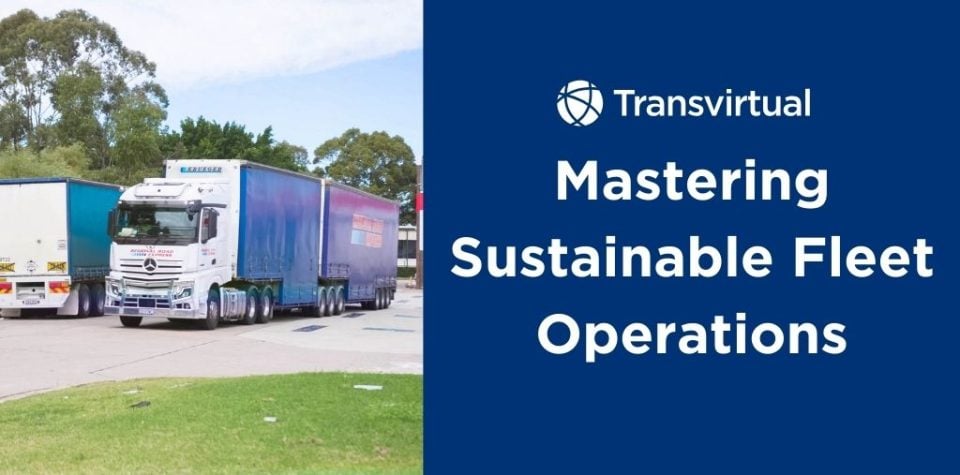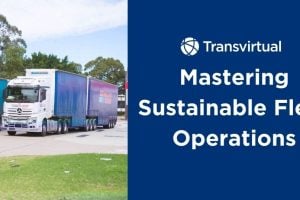Table of Contents
As a fleet worker, your main responsibility is accountability. This means following routes and meeting deliverables, but nowadays, it also includes optimizing workflows and processes to be more eco-conscious. Industrial corporations, their stakeholders, drivers and everyone involved must shoulder this responsibility to improve the sector heading into 2025. How is this achieved?
Why Are Sustainable Fleet Operations Important in 2025?
Your team needs to focus on sustainability in 2025 for three main reasons. The cost savings are the most instantly gratifying motivators. Fuel prices are constantly rising, and the stress of market volatility hinders the team’s productivity and morale. Costs for fleets rose 21.3% in 2022, and fuel was a leading factor. Investing in sustainable fleets will save money and improve morale, making you more competitive.
It will also keep you ahead of any regulatory compliance shifts. Governments and certifying agencies are heightening expectations as more research about transportation’s impact on the climate crisis comes to light. Greener driving could save fleets from fines and legal repercussions for not adhering.
As your team adopts sustainable practices, you may notice growth in customer satisfaction and public perception. Companies and buyers want to partner with and support eco-friendly organizations. You will also start to attract like-minded businesses, eventually making it easier to partner with similarly motivated parties to better everyone’s environmental, social and governance objectives.
What Are the Main Qualities of Eco-Friendly Fleets?
What does it mean to run a sustainable fleet operation?
- Fuel efficiency: Fleets need to steer away from fossil fuels — the best approach is to electrify them. Their strategy could include a mixed fleet of hybrid and fully electric vehicles, as well as infrastructure to charge and maintain machinery to preserve their life spans. This will eliminate mechanical, electrical and chemical waste.
- Optimized routing: Many drivers waste fuel and time on long routes, causing extra emissions. Sustainable fleets streamline paths so drivers save resources.
- Driver training: Driving habits directly affect the planet. Smart brake usage, reduced idling, and smooth acceleration are critical for saving fuel and preventing wear and tear on heavy haulers. Harsh stops eventually put the vehicle’s body under stress, but it immediately emits microplastics and other contaminants from tires — fleets often overlook this element.
- Sustainable partnerships: When you drive sustainably, the cargo should also reflect these values. The products should be mindful of the climate, including items made from recycled materials or multiuse replacements for single-use staples.
What Are the Best Strategies for Maintaining Sustainable Fleets?
These are the best business practices to advocate for and implement in your fleets, contextualized by their benefits for workers and the environment.
1. Adoption of Alternative Fuels
Hybrid and electric cars could run on renewable energy if fleets have the technology to support them, making them carbon-neutral transportation options. If electrification is not possible, consider other green options such as hydrogen. Both options yield lower fuel costs, government incentives, and reputation boosts from clients and consumers.
The best way to start with alternative fuels or electric fleets is to see what assistance is available. It’s helpful to inform these choices by what grants, tax credits and more are accessible, especially if budgets are strained.
2. Implement Fleet Telematics
Fleet telematics is a nonnegotiable resource for greener fleets. Oftentimes, these assets are powered by next-generation technologies like artificial intelligence (AI) and sensor-based equipment, making every driver smarter than ever. They let drivers, procurement teams, logistics managers, and stakeholders know the status of every item and vehicle in the inventory at all times.
This boosted visibility makes drivers more responsible and dependable, as it can also track driving behaviors. As it learns their habits, the software can suggest improvements or other routes for reducing emissions even more.
To start with telematics, reach out to certified, secure third-party vendors. Prioritize ones with sustainable features like measuring relevant key performance indicators.
3. Conduct Regular Vehicle Maintenance
Drivers must make their long-haul trucks last as long as possible. The fleet management team must also provide resources to keep it in the best shape possible. The more workers maintain vehicles, the better their life cycle assessment.
Additionally, overextending machinery is a leading cause of waste from the fleet industry. The amount of electronics, metals and plastics in the vehicles must go down. Only install new parts or repair when necessary — overmaintaining can create as much waste as neglect.
To start establishing healthy maintenance habits, establish rules for how your team records repair schedules. Include plenty of time for visual inspections, monitor warranties and expiration dates, and incorporate checks and balances so everyone can drive with confidence.
4. Implement a Fleet Rightsizing Strategy
Fleet rightsizing must become standard practice. It is so important that New York City incorporated it as part of its Fleet Management Manual, extending responsibilities even to SUVs and minivans.
Your team might load a truck for just one client, wasting space on long trips. In an optimal scenario, drivers would have a full vehicle with a smart route plan, taking care of as many deliverables with the greatest fuel and space efficiency as possible. Maximizing space boosts asset utilization and reduces operating costs, which are sometimes invested in environmentally destructive resources like fossil fuels.
Crews may not use fleet rightsizing because the appropriate dimensions are unavailable. They could use a smaller hauler, but your department only has something twice the size. If this is the primary barrier, consider creating a policy of when it is approved to lease smaller vehicles.
Additionally, managerial teams should have regular meetings with drivers to establish fleet size needs in accordance with client demand. The drivers and loaders will have the best insights.
Creating Greener Fleets
Fleet drivers must take environmental obligations more seriously in 2025. Adopting these practices only requires a few simple actions to get the ball rolling, which can lead to long-lasting, monumental carbon reductions and resource savings. Though managers are in charge of deciding what changes to implement, the team’s effort makes these choices even more impactful.

